Accounting Ratios Important Questions for CBSE Class 12 Accountancy Classification of Accounting Ratios
Classification of Accounting Ratios
In view of the requirements of various users, the accounting ratios may be classified as under
1.Liquidity Ratios Liquidity ratios measure the firm’s ability to fulfil its short-term financial obligations.
(i)Current ratio/Working capital ratio This ratio establishes relationship between current assets and current liabilities and is used to assess the short-term financial position of the business concern. Current ratio of 2:1 is considered to be ideal.
Current Ratio/Working Capital Ratio=Current Assets/Current Liabilities
Items Included in Current Assets
(a)Current investments
(b)Inventories (Excluding loose tools, stores and spares)
(c)Trade receivables (bills receivable and sundry debtors less provision for doubtful debts)
(d)Cash and cash equivalents (cash in hand, cash at bank, cheques/drafts in hand)
(e)Short-term loans and advances
(f)Other current assets (prepaid expenses, interest receivable, etc.)
Items Included in Current Liabilities
(a)Short-term borrowings
(b)Trade payables (bills payable and sundry creditors)
(c)Other current liabilities (current maturities of long-term debts, interest, accrued but not due on borrowings, interest accrued and due on borrowings, outstanding expenses, unclaimed dividend, calls-in-advance, etc)
(d)Short-term provisions
(ii) Liquid ratio/Quick ratio/Acid test ratio This ratio establishes relationship between liquid assets and current liabilities and is used to measure the firm’s ability to pay the claims of creditors immediately. This ratio is a better indicator of liquidity and 1 : 1 is considered to be ideal.
Liquid Ratio/Quick Ratio/Acid Test Ratio=Liquid Assets or Quick Assets/Current Liabilities
Items Included in Liquid/Quick Assets
(i)Current investments.
(ii)Trade receivables (bill receivables, debtors less provisions for doubtful debts).
(iii)Cash and cash equivalents.
(iv)Short-term loans and advances.
(v) Other current assets except prepaid expenses.
Items excluded in liquid assets are inventories, prepaid expenses.
Items Included in Current Liabilities
(i)Short-term borrowings.
(ii)Trade payables (bills payable and sundry creditors).
(iii)Other short-term liabilities.
(iv)Short-term provisions.
2.Solvency Ratios Solvency ratios judge the long-term financial position of an enterprise i.e.whether business is able to pay its long-term liabilities or not.
(i)Debt to Equity ratio It establishes the relationship between long-term debt (external equities) and the equity (internal equities) i.e. shareholders’ funds. It is computed to ascertain soundness of the long-term financial position of the firm.
Generally, the ratio of 2 : 1 is considered as an ideal.
Debt to Equity Ratio=Debt (Long-term external equities)/Equity (Shareholders funds)
Items Included in Long-term Debts It includes long-term borrowings and long-term provisions.
Items Included in Equity or Shareholders’ Funds
Equity or Shareholders’ Funds = Equity Share Capital + Preference Share Capital+ Reserves and Surplus
or
Non-current Asset (Tangible assets + Intangible assets + Non-current trade investments + Long-term loans and advances) + Working Capital – Non-current Liabilities (Long-term borrowings + Long-term provisions)
[Working Capital = Current Assets – Current Liabilities]
(ii)Proprietary ratio It establishes the relationship between proprietors’ funds and total assets.
Proprietary Ratio=Proprietors’ Funds or Shareholders’ Funds/Total Assets
Proprietors’ Funds or Shareholders’ Funds
Liabilities Approach Share Capital + Reserves and Surplus
or
Assets Approach
Non-current Assets (Tangible assets + Intangible assets + Non-current trade
investments + Long-term loans and advances) + Working Capital – Non-current Liabilities (Long-term borrowings + Long-term provisions)
Total Assets
Total assets include
(a)Non-current Assets [Fixed assets (Tangible and intangible assets) + Non-current Investments + Long-term Loans and Advances
(b)Current Assets [Current investments + Inventories (including spare parts and loose tools) + Trade Receivables + Cash and Cash Equivalents + Short-term Loans and Advances + Other Current Assets]
(iii)Total assets to debt ratio It establishes a relationship between total assets and total long-term debts.
Total Assets to Debt Ratio=Total Assets/Long-term Debts
Items Included in Total Assets
Total Assets It includes
■ Non-current Assets [Fixed assets (Tangible and intangible assets) + Non-current Investments + Long-term Loans and Advances
■ Current Assets [Current investments + Inventories (including spare parts and loose tools) + Trade Receivables + Cash and Cash Equivalents + Short-term Loans and Advances + Other Current Assets]
Items Included in Long-term Debts
(a)Long-term borrowings
(b)Long-term provisions
(iv)Interest coverage ratio This ratio expresses the relationship between net profit before interest and tax and interest payable on long-term debts. The ideal coverage ratio is 6 to 7 times.
Interest Coverage Ratio =Net Profit before Interest and Tax/Interest on Long-term Debts
3.Turnover or Performance or Activity Ratios These ratios measure how efficiently a company is using its assets to generate sales.
(i) Stock turnover ratio or Inventory turnover ratio The ratio indicates the number of times the stock is turned in sales during the accounting period, i.e. it measures how fast the stock is moving through the firm and generating sales.
Stock or Inventory Turnover Ratio=Cost of Revenue from Operations i. e. Cost of Goods Sold/Average Inventory
Cost of Revenue from Operations i.e. Cost of Goods Sold
= Cost of Materials Consumed + Purchases of Stock-in-trade + Changes in
Inventories of Finished Goods, Work-in-progress and Stock-in-trade + Direct Expenses
or
= Opening Inventory + Purchases + Direct Expenses – Closing Inventory
or
= Revenue from Operations i.e. Sales – Gross Profit
Average Inventory =(Opening Inventory + Closing Inventory)/2
(ii)Trade Receivables or Debtors turnover ratio It indicates economy and efficiency in the collection of amount due from debtors.
Debtors/Trade Receivables Turnover Ratio=Credit Revenue from Operations i. e. Net Credit Sales/Average Trade Receivables
- Credit Revenue from Operations i.e. Net Credit Sales = Credit Sales – Sales Return or
- Credit Revenue from Operations = Revenue from Operations – Cash Revenue from Operations
- Average Trade Receivables = Opening Receivables (Debtors + Bills Receivable) +Closing Receivables (Debtors + Bills Receivable)/2
If information about opening balances of debtors and bills receivable is missing, then only closing debtors and bills receivable will be considered.
Also, if credit sales are not specified, then total sales will be deemed to be on credit.
[Average Collection Period =(Number of Days/ Weeks / Months in a Year )/Debtors Turnover Ratio]
(iii)Trade payables or Creditors turnover ratio It indicates the speed with which the amount is being paid to creditors. The higher the ratio, the better it is.Creditors/Payables Turnover Ratio =Net Credit Purchases/Average Payables
Net Credit Purchases = Credit Purchases – Purchase Return.
In the absence of opening creditors and bills payable, closing creditors and bills payable can be used in the above formula. Also, if credit purchases are not given, then all purchases are deemed to be on credit.
Average Payables=Opening Payables (Creditors + Bills Payable) + Closing Payables (Creditors + Bills Payable)/2
Average Payment Period=(Number of Days/ Weeks / Months in a Year)/Creditors Turnover Ratio
(iv)Working capital turnover ratio This ratio shows the number of times the working capital has been rotated in generating sales.
Working Capital Turnover Ratio=Cost of Revenue from Operations or Revenue from Operations i. e. Net Sales/Working Capital
Working Capital = Current Assets – Current Liabilities
4.Profitability Ratios These ratios measure the profitability of a business assessing the and helps in overall efficiency of the business.
(i) Gross profit ratio Gross profit ratio shows the relationship between the gross profit to net sales (revenue from operations)
Gross Profit Ratio =Gross Profit/Revenue from Operations i.e. Net Sales x 100
Cost of Revenue from Operations = Opening Inventory (excluding spare parts and loose tools) + Purchases + Direct Expenses – Closing Inventory (excluding spare parts and loose tools)
In case, statement of profit and loss is given, cost of revenue from operations i.e. cost of goods sold is computed by adding cost of materials consumed, purchases of stock-in-trade, changes in inventories of finished goods, work-in-progress and stock-in-trade and direct expenses
(ii)Net profit ratio Net profit ratio shows the relationship between net profit and revenue from operations i.e. net sales. Net profit ratio is an indicator of overall operational efficiency of the business.
Net Profit Ratio =Net Profit after Tax/Revenue from Operations i. e. Net Sales x 100
Net Profit = Revenue from Operations – Cost of Revenue from Operations – Operating Expenses – Non-operating Expenses + Non-operating Income + Tax
(iii)Operating ratio Operating ratio establishes the relationship between operating cost and revenue from operations i.e. net sales.
Operating Ratio =Operating Cost/ Revenue from Operations (Net sales) x 100
Operating Ratio =Cost of Revenue from Operations + Operating Expenses/Revenue from Operations i.e. Net Sales x 100
Cost of Goods Sold = Cost of Materials Consumed + Purchases of Stock-in-trade + Change in Inventories of Finished Goods, Work-in-progress and Stock in-trade + Direct Expenses
or
Revenue from Operations – Gross Profit.
Operating Expenses = Employees Benefits Expenses + Other Expenses (Other than non-operating expenses) + Depreciation and Amortisation Expenses
or
Office expenses, administrative expenses, selling and distribution expenses, employees benefit expenses, depreciation and amortisation expenses.
Alternatively operating cost may be calculated as follows:
Operating Cost = Cost of Materials Consumed + Purchases of Stock-in-trade + Change in Inventories of Finished Goods, Work-in-progress and Stock-in-trade + Employees Benefits Expenses + Other Expenses (Other than non-operating expenses)
(iv)Operating profit ratio Operating profit ratio establishes the relationship between the operating profit and i.e. (revenue from operations) net sales. Operating profit ratio is an indicator of operational efficiency of the business.
(v)Return on investment/Capital employed It establishes the relationship between net profit before interest, tax and preference dividend and capital employed (equity + debts).
Return on Investment/Capital Employed=Net Profit before Interest, Tax and Preference Dividend/ Capital Employed x 100
Capital employed can be calculated from liabilities side approach and assets side approach as follows:
When Liabilities Approach is Followed It is computed by adding
(a)Shareholders’ funds (i.e. share capital, reserves and surplus).
(b)Non-current liabilities (i.e. long-term borrowings and long-term provisions).
When Assets Approach is Followed It is computed by adding
(i)Non-current assets, i.e.
(a)Fixed assets (tangible fixed assets, intangible fixed assets).
(b)Non-current trade investments.
(c)Long-term loans and advances.
(ii)Working capital, i.e. current assets – current liabilities.
NOTE Since,non-operating assets are excluded while determining capital employed, income from non-operating assets should also be excluded from profit.
Previous Years’Examinations Questions
1 Mark Questions
1.State with reason whether repayment of long-term loan will result in increase,decrease or no change of debt equity ratio. (All India 2012; hots)
Ans. Repayment of long-term loan will reduce the long-term debt but the shareholders’funds will remain same. Therefore, the debt-equity ratio will decrease.
2.What will be the operating profit ratio, if operating ratio is 83.64%? (Delhi 2009)
Ans.Operating Profit Ratio = 100 – Operating Ratio
= 100- 83.64 = 16.36%
3.What will be the operating profit ratio, if operating ratio is 88.94%? (Delhi 2009)
Ans.Operating Profit Ratio = 100 – Operating Ratio
= 100- 88.94 = 11.06%
4.What will be the operating profit ratio, if operating ratio is 81.38%? (All India 2009)
Ans.Operating Profit Ratio = 100 – Operating Ratio
= 100- 81.38 =18.62%
5.What will be the operating profit ratio, if operating ratio is 88.34%? (All India 2009)
Ans.Operating Profit Ratio = 100 – Operating Ratio = 100- 88.34 = 11.66%.
6.The gross profit ratio of a company is 50%. State with reason whether the decrease in rent received by Rs 15,000 will increase, decrease or not change the ratio.(Delhi 2009; HOTS)
Ans. Decrease in rent received by Rs 15,000 will not change the gross profit because rent received is a non-operating income.
7.The current ratio of a company is 3 : 1. State with reason, whether the payment of ? 20,000 to the creditors will increase, decrease or not change the ratio.(All India 2009; HOTS)
Ans. After the payment of ? 20,000 to the creditors, both the total of current assets and total of current liabilities will be reduced by the same amount. Therefore, the current ratio will increase.
8.Quick ratio of a company is 1.5:1. State giving reason whether the ratio will improve, decline or not change on payment of dividend by the company. (Delhi 2008; hots)
Ans. Ratio will increase as both the current assets and current liabilities will decrease on the payment of dividend.
9.The inventory turnover ratio of a company is 3 times. State giving reason, whether the ratio will improve, decline or not change because of increase in the value of closing Inventory by ? 5,000.(Delhi 2008; hots)
Ans. Stock turnover ratio will decline because increase in the value of closing stock by ?5,000 will increase the value of average Inventory and decrease the cost of goods sold.
10.The debt-equity ratio of a company is 0.8:1. State whether the long-term loan obtained by the company will improve, decrease or not change the ratio. (All India 2008; hots)
Ans. Debt equity ratio will improve as the long-term debts will decrease, but total shareholders’ funds remain unchanged.
3 Marks Questions
11.OM Ltd has a current ratio of 3.5 : 1 and quick ratio of 2 : 1. If the excess of current assets over quick assets as represented by inventory is Rs 1,50,000, calculate current assets and current liabilities. (Delhi2012)
Ans.
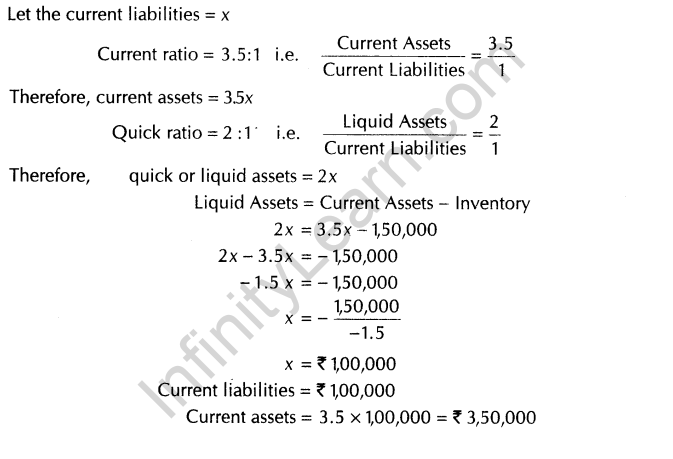
12.X Ltd has a current ratio of 3 : 1 and quick ratio of 2 :1. If the excess of current assets over quick assets as represented by inventory is Rs 40,000, calculate current assets and current liabilities. (All India 2012)
Ans.
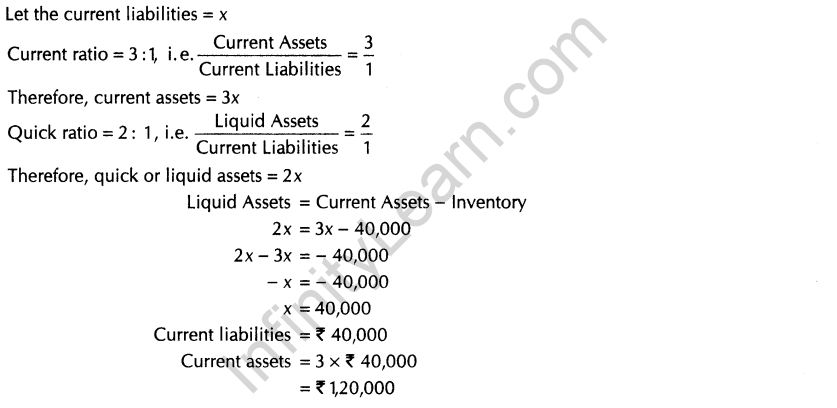
13.From the following information, calculate any two of the following ratios
(i)Debt-equity ratio
(ii)Working capital turnover ratio (iii) Return on investment
Information Equity share capital Rs 10,00,000, general reserve Rs 1,00,000, balance of statement of profit and loss after interest and tax Rs 3,00,000, 12% debentures Rs 4,00,000, creditors Rs 3,00,000, land and buildings Rs 13,00,000, furniture Rs 3,00,000, debtors 12,90,000, cash Rs 1,10,000.Revenue from operations i.e. sales for the year ended 31st March, 2011 was Rs 30,00,000. Tax rate is 50%. (All India 2012; Modified)
Ans.


14.On basis of the following information, calculate
(i)Debt equity ratio
(ii)Working capital turnover ratio
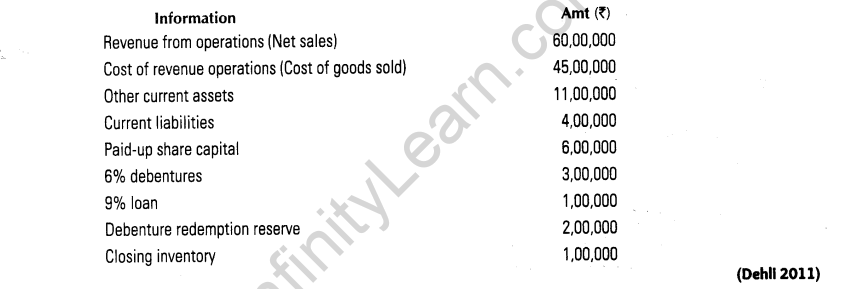
Ans.


15.On the basis of the following information, calculate
(i)Debt equity ratio (ii) Working capital turnover ratio
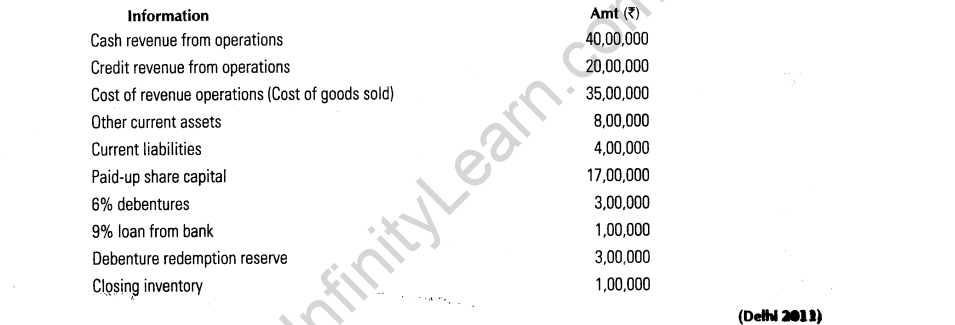
Ans.
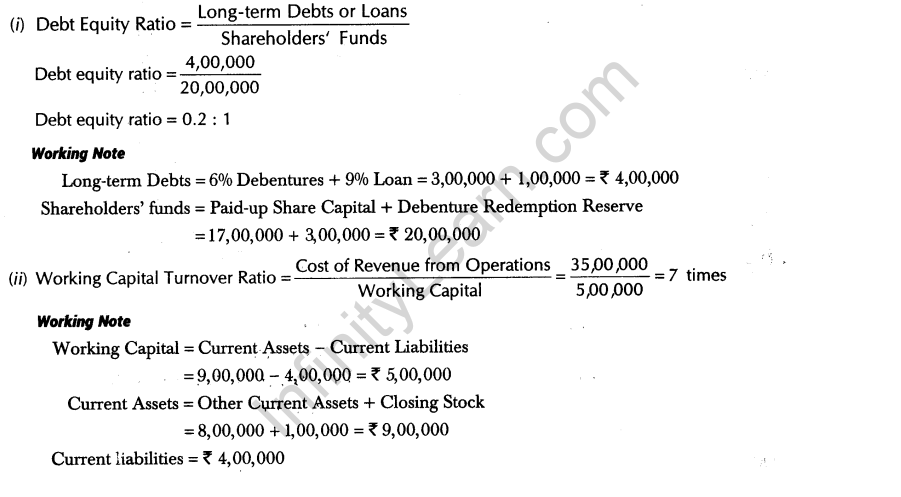

Ans.
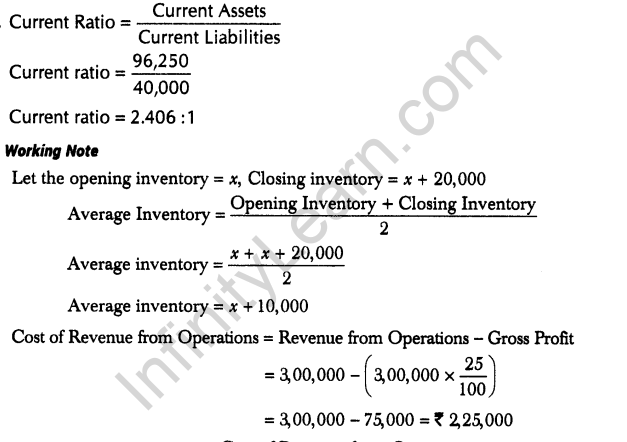

17.The quick ratio of a company is 2 : 1. State giving reasons, (for any four) which of the following would improve, reduce or not change the ratio
(i)Purchase of machinery for cash
(ii)Purchase of goods on credit (iii) Sale of furniture at cost
(iv)Sale of goods at a profit
(v)Cash received from debtors (Delhi 2011 c)
Ans. (i) Purchase of machinery for cash
Effect Reduce
Reason Purchase of machinery for cash will decrease the quick assets, but the current liabilities remain unchanged.
(ii) Purchase of goods on credit
Effect Reduce
Reason Purchase of goods on credit will increase the current liabilities, but the quick assets remain unchanged.
(iii) Sale of furniture at cost
Effect Improve
Reason Sale of furniture at cost will increase the quick assets, but the current liabilities remain unchanged.
(iv)Sale of goods at a profit
Effect Improve
Reason Sale of goods at a profit will increase the quick assets, but the current liabilities remain unchanged.
(v)Cash received from debtors
Effect No change
Reason Cash received from debtors will not change the quick assets because the quick assets are increased and decreased with the same amount, and the current liabilities remain unchanged.
18.The debt equity ratio of a company is 1:1 state giving reasons, (any four) which of the following would improve, reduce or not change the ratio
(i)Purchase, of machinery for cash
(ii)Purchase of goods on credit (iii) Sale of furniture at cost
(iv)Sale of goods at a profit
(v)Redemption of debentures at a premium (All India 2011)
Ans. (i) Purchase of machinery for cash
Effect No change
Reason Neither the long-term debt nor the shareholders’ funds are affected by purchasing of machinery for cash.
(ii)Purchase of goods on credit
Effect No change
Reason Neither the long-term debt nor the shareholders’ funds are affected by purchasing of goods on credit.
(iii)Sale of furniture at cost
Effect No change
Reason Neither the long-term debt nor the shareholders’ funds are affected by selling of furniture at cost.
(iv)Sale of goods at a profit
Effect Reduce
Reason Shareholders’ funds are increased by the amount of profit on sale of goods, but the long-term debts remain unchanged.
(v)Redemption of debentures at a premium
Effect Reduce
Reason Redemption of debentures will reduce the long-term debts, but shareholders’ funds remain unchanged. Here,it is assumed that premium payable on redemption of debenture is written-off through existing securities premium.
19.(i)A business has a current ratio of 3 : 1 and quick ratio of 1.2 : 1. If the working capital is Rs 1,80,000. Calculate the total current assets and value of inventory.
(ii) From the given information calculate the inventory turnover ratio. Revenue from operations (Sales) Rs 2,00,000, gross profit 25% on cost, inventory at the beginning is 1/3 of the inventory at the end which was 30% of sales. (Delhi 2010; All India 2010)
Ans.
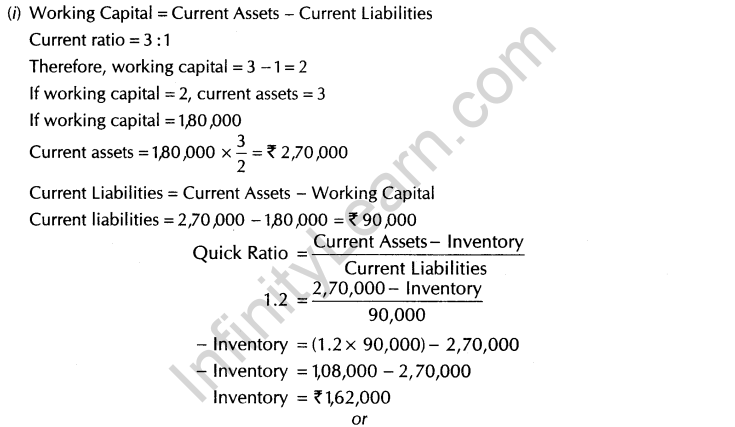
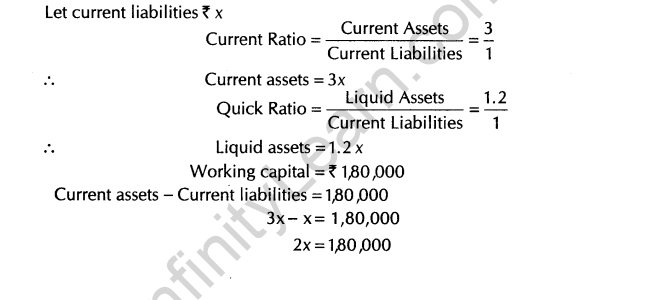
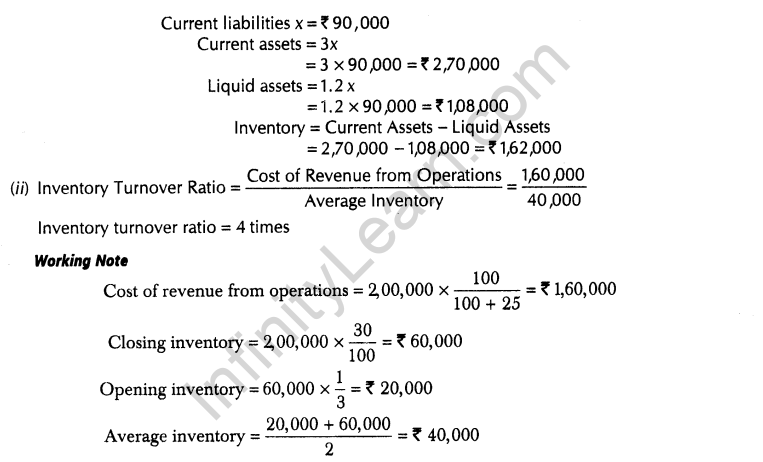
20.Assuming that the debt equity ratio is 2. State giving reasons whether this ratio would increase, decrease or remain unchanged in the following cases. (Any four)
(i)Purchase of fixed assets on a credit of two months
(ii)Purchase of fixed assets on long-term deferred payment basis
(iii)Issue of new shares for cash
(iv)Issue of bonus shares
(v)Sale of fixed assets at a loss of 13,000. (Delhi 2010; All India 2010)
Ans. (i) Purchase of fixed assets on a credit of two months
Effect No change
Reason Neither the long-term debt nor the shareholders’ funds are affected by purchasing of fixed assets on a credit of two months.
(ii) Purchase of fixed assets on a long-term deferred payment basis
Effect Increase
Reason The long-term debts are increased by the purchasing of fixed assets on a long-term deferred payment basis, but the shareholders’ fund remains unchanged.
(iii)Issue of new shares for cash
Effect Decrease
Reason Shareholders’ funds are increased by the issue of new shares for cash, but the long-term debts remain unchanged.
(iv) Issue of bonus shares
Effect No change
Reason Shareholders’ funds increase and decrease by the same amount.
(v) Sale of fixed assets at a loss of Rs 3,000
Effect Increase
Reason The shareholders’ funds will reduce by the amount of loss of 3,000, but the long-term debt remain unchanged.
21.From the following information, calculate any two of the following ratios
(i)Current ratio
(ii)Debt equity ratio
(iii)Inventory turnover ratio
Information
Revenue from operations (Net sales) Rs 5,00,000, opening inventory Rs 7,000, closing inventory Rs 4,000 more than the opening inventory, net purchase Rs 1,00,000 less than revenue from operations, operating expenses Rs 30,000, liquid assets Rs 75,000, prepaid expenses Rs 2,000, current liabilities Rs 60,000, 9% debentures Rs 3,00,000, long-term loan from bank Rs 1,00,000 equity share capital Rs 10,00,000 and 8% preference share capital Rs 2,00,000. (Delhi 2010 c)
Ans.
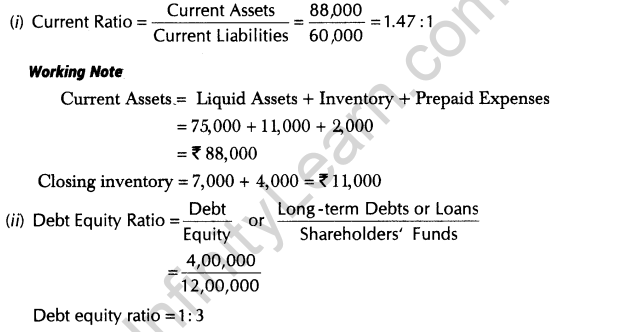
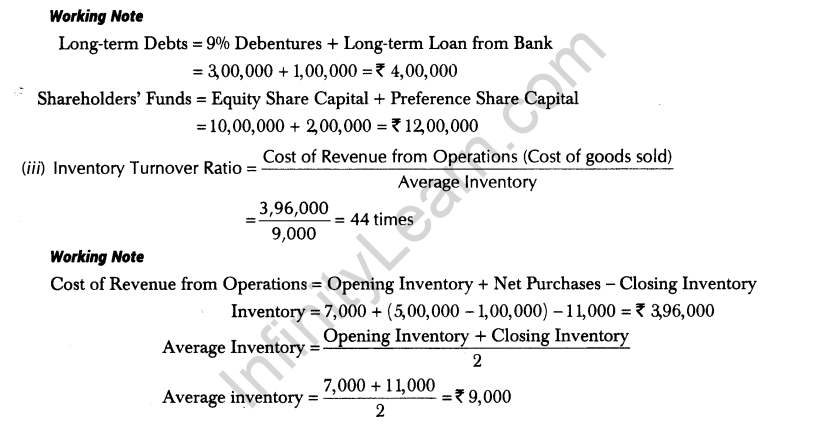
22.From the following information, calculate any two of the following ratios (i) Liquid ratio (ii) Gross profit ratio (iii)Debt equity ratio
Information
Revenue from operations (Net sales) Rs 4,00,000, opening inventory Rs 10,000, closing inventory Rs 3,000 less than the opening inventory, net purchase 80% of revenue from operations, direct expenses Rs 20,000, current assets Rs 1,00,000, prepaid expenses Rs 3,000, current liabilities Rs 60,000, 9% debentures Rs 4,00,000, long-term loan from bank Rs 1,50,000, equity share capital Rs 8,00,000 and 8% preference share capital Rs 3,00,000. (All india 2010)
Ans.
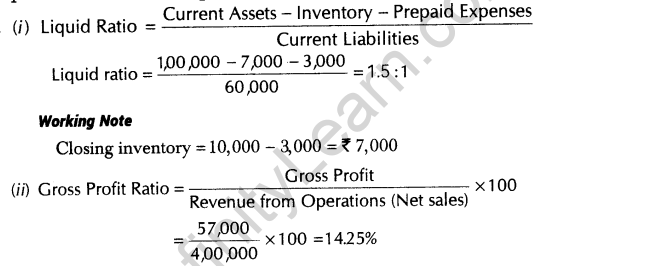
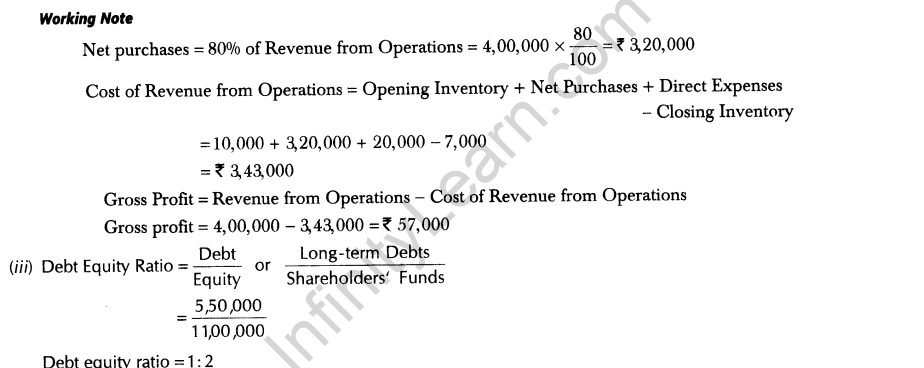

23.(i) Net profit after interest but before tax Rs 1,40,000, 15% long-term debts Rs 4,00,000,shareholders’ funds Rs 2,40,000 and tax rate 50%. Calculate return on capital employed.
(ii) Opening inventory Rs 60,000, closing inventory Rs 1,00,000, inventory turnover ratio 8 times and selling price 25% above cost. Calculate the gross profit ratio.
Ans.
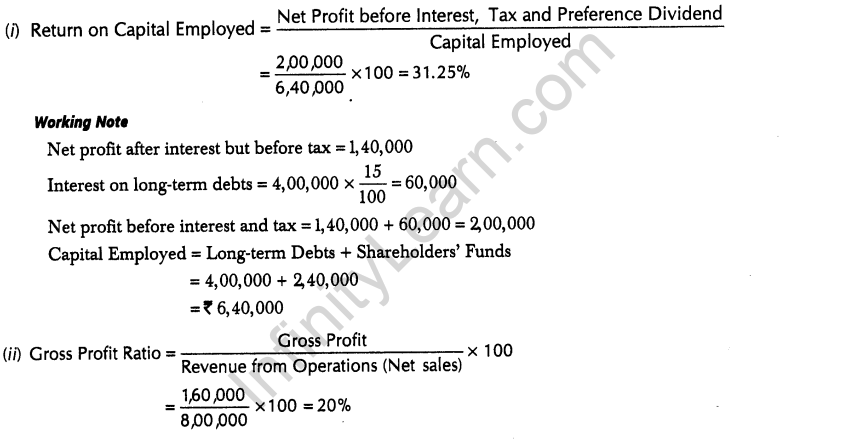
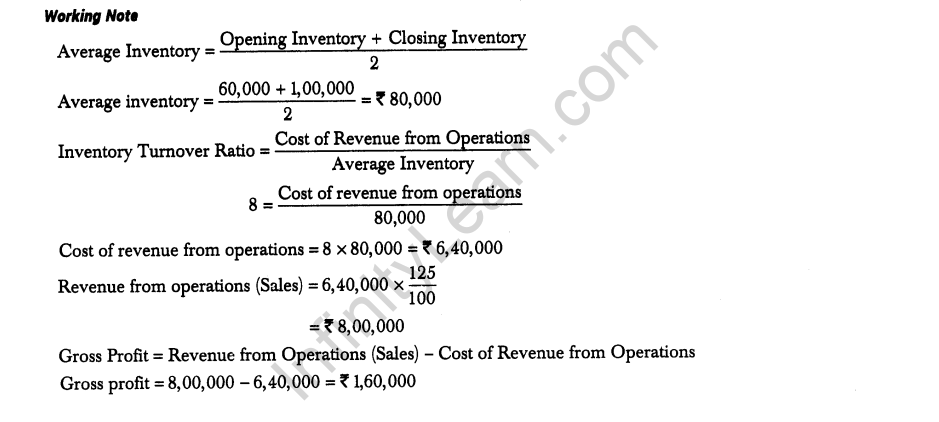
24.From the following information, calculate the following ratios
(i)Liquid ratio
(ii)Proprietary ratio
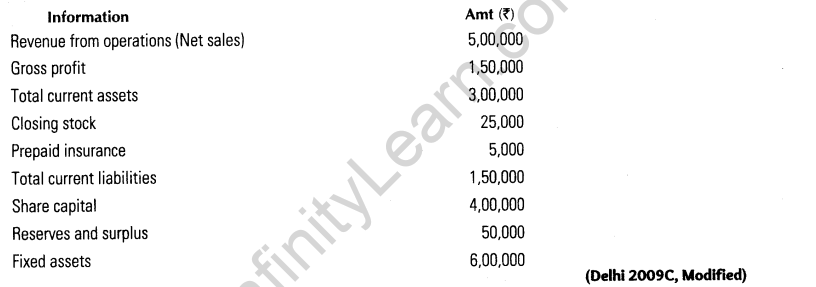
Ans.
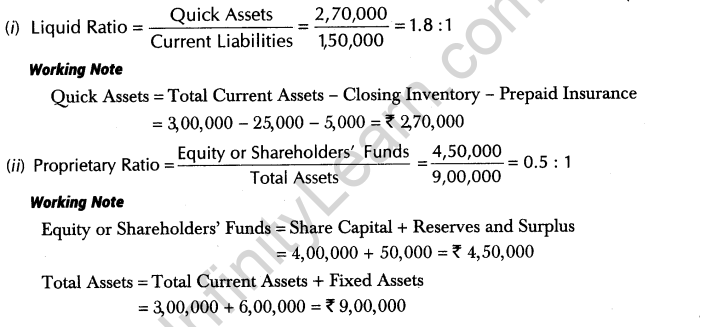
25.From the following information, calculate any two of the following ratios
(i) Operating ratio (ii) Inventory turnover ratio (iii) Proprietary ratio
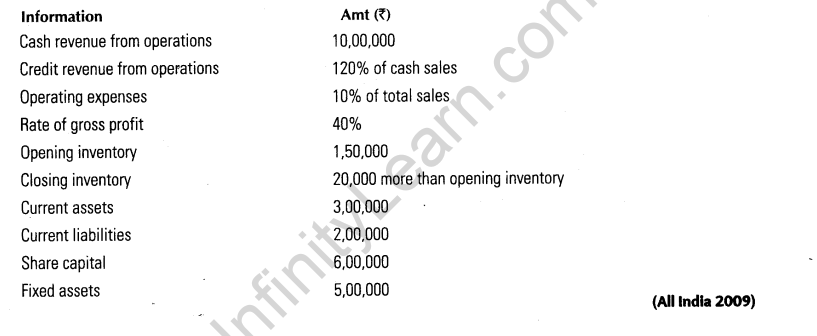
Ans.


26.From the following information, calculate any two of the following ratios (i) Liquid ratio (ii) Debt equity ratio
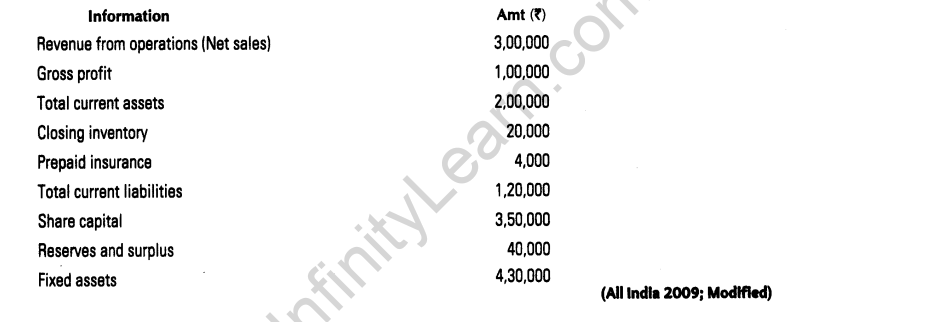
Ans.
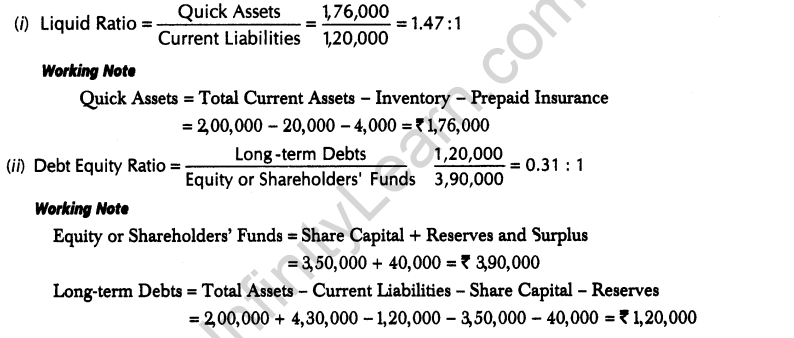
27.From the following information, calculate any two of the following ratios (i) Net profit ratio (ii) Debt equity ratio
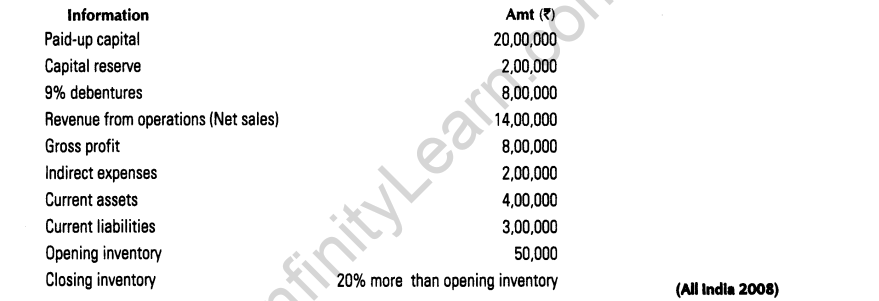
Ans.
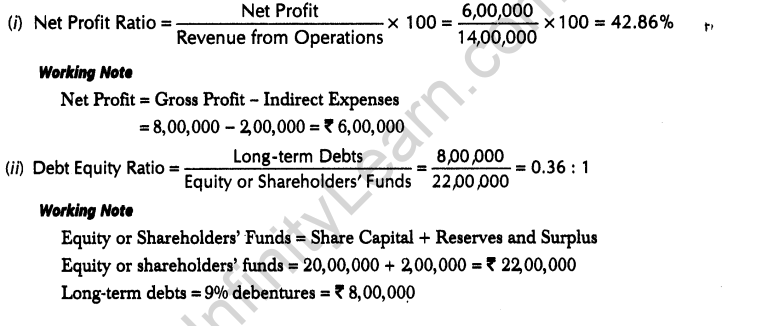
4 Marks Questions
28.From the following calculate the ‘gross profit ratio’ and ‘working capital turnover ratio’:

Ans.
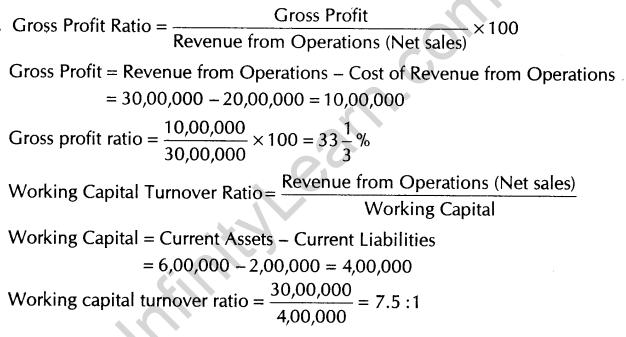
29.(i)From the following information, compute ‘debt equity ratio’
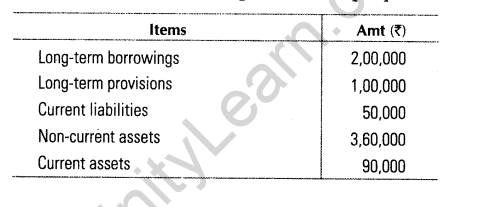
(ii) The current ratio of X Ltd is 2 : 1. State with reason which of the following transaction would increase, decrease or not change the ratio
(a)Included in the trade payables was a bills payable of Rs 9,000 which was met on maturity.
(b)Company issued 1,00,000 equity shares of Rs 10 each to the vendors of machinery purchased. (Delhi 2014)
Ans.
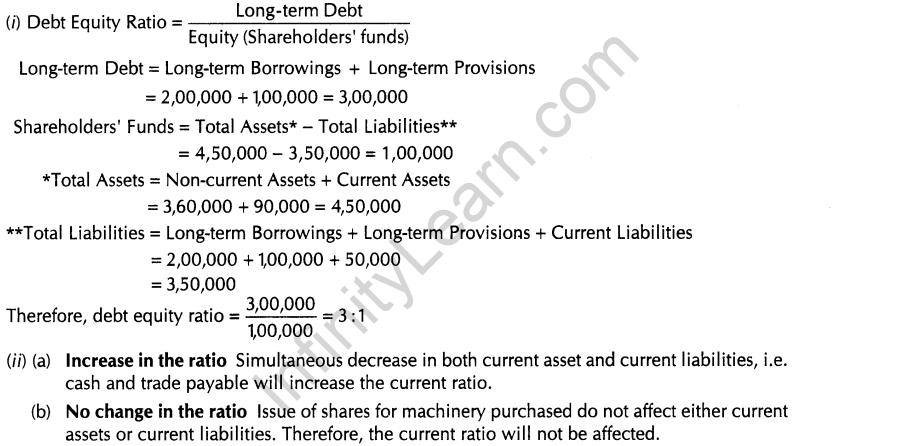
30.The quick ratio of a company is 1.5 : 1. State with reason which of the following
transactions would (a) increase (b) decrease or (c) not change the ratio
(a)Paid rent Rs 3,000 in advance.
(b)Trade receivables included a debtor Shri Ashok who paid his entire amount due Rs 9,700.
(ii) From the following information compute ‘proprietary ratio’

Ans. (i) (a) Not change the ratio
Reason As there is a simultaneous increase and decrease in current asset, i.e. prepaid expenses and cash, therefore it will not affect the value of current asset.
(b) Not change the ratio
Reason As there is a simultaneous increase and decrease it will not affect the value of current asset.
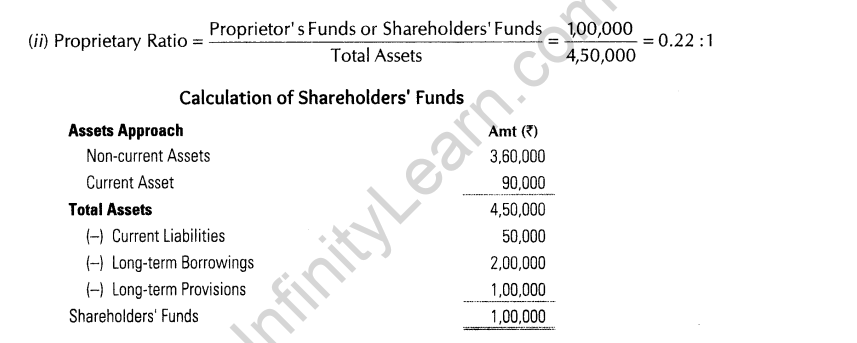
31.From the following calculate:
(i) Operating profit ratio; and (if) Working capital turnover ratio
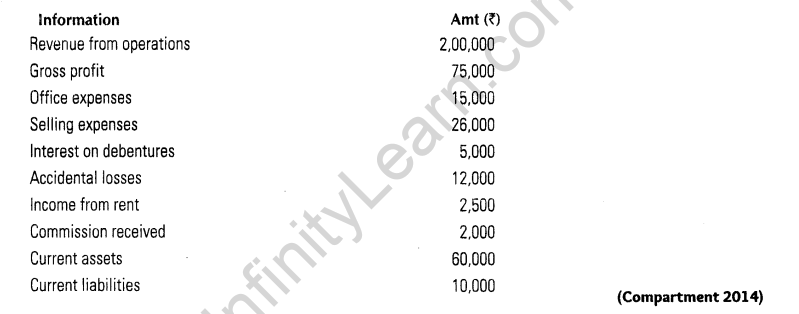
Ans.
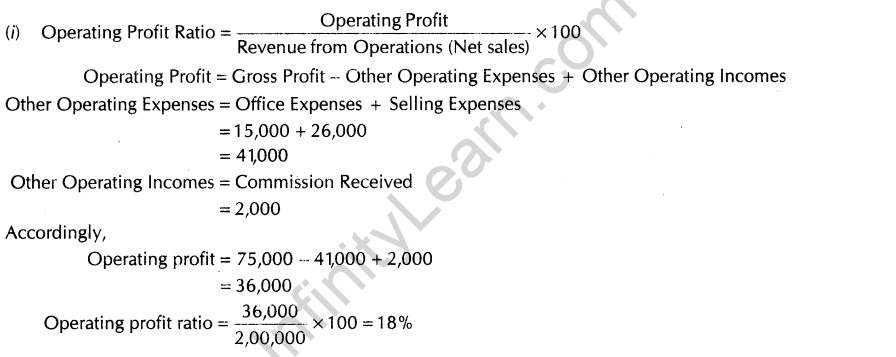

32. (i) Compute ‘debtors turnover ratio’ from the following information Revenue from operations (Total sales) Rs 5,20,000, cash revenue from operations 60% of the credit revenue from operations closing debtors Rs 80,000, opening debtors are 3/4th of closing debtors.
(ii) Current liabilities of a company are Rs 1,60,000. Its liquid ratio is 1.5 : 1 and current ratio is 2.5 : 1. Calculate quick assets and current assets. (All India 2013)
Ans.
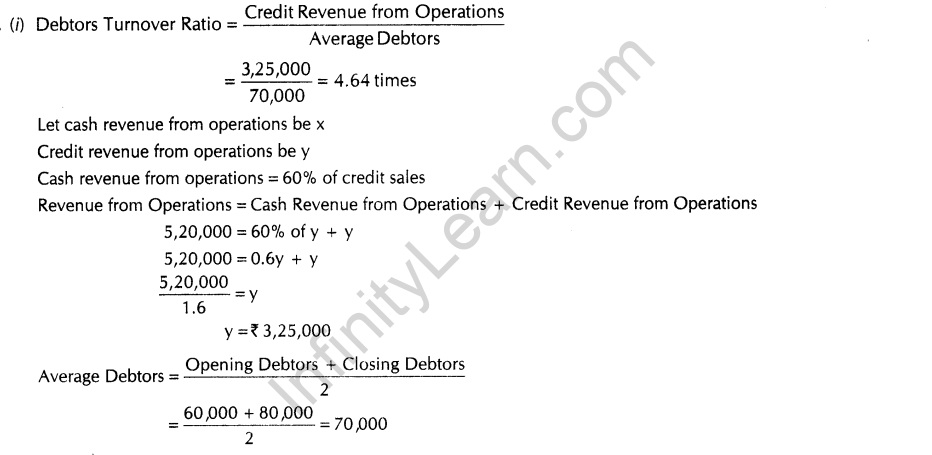

33.(i)Compute ‘working capital turnover ratio’ from the following information Cash revenue from operations Rs 1,30,000, credit revenue from operations Rs 3,80,000, sales returns Rs 10,000, liquid assets Rs 1,40,000, current liabilities Rs 1,05,000 and inventory Rs 90,000.
(ii) Calculate ‘debt equity ratio’ from the following information Total assets Rs 3,50,000, total debt Rs 2,50,000 and current liabilities Rs 80,000.(Delhi 2013)
Ans.

34.From the following information, calculate any two of the following ratios
(i)Gross profit ratio
(ii)Working capital turnover ratio
(iii)Proprietary ratio

Ans.





